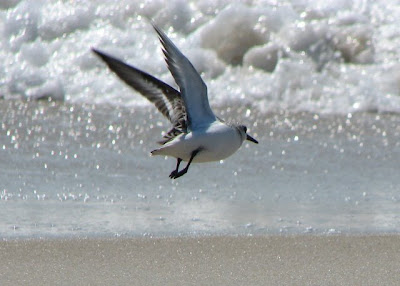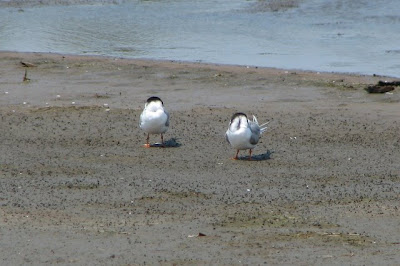It's not the end of bird migration - not this year, and not even this season. It's the end of our redetermined migration, south along the Atlantic coast to our final destination, Chincoteague National Wildlife Refuge. Summer and late Autumn are when we usually visit, I cannot find any birding checklist dated earlier than July 03. We finally made it to find out what a spring time visit would be like.
As expected, it was awesome. Too short, as our week-long stay would be cut to a mere three days, but we managed a lot of fun playing on they sandy beaches, riding our bikes around Assateague Island and riding Chincoteague Ponies on Chincoteague. And, of course, lots of bird watching though I didn't manage any early morning trips into the woods for migrating landbirds.
Our house overlooks Assateague Bay, the neighborhood best described as "sleepy" in the sense there is minimal traffic to bother you as you search the planted vegetation for landbirds, including expected spring birds like Brown-headed Nuthatches, Carolina Chickadees, Barn Swallows, Northern Mockingbirds, Common Yellowthroat, and so on. Overlooking the bay provides a variety of habitat types: tide-dependent mudflats for Greater and Lesser Yellowlegs, oyster beds hosting American Oystercatchers, marshes for Clapper Rails, herons, egrets, Northern Harriers, and Purple Martins, and, of course, open water for Great Black-backed Gulls, Forster's and Least Terns, Osprey, and waterfowl in the winter months. Although our trips are short and almost exclusively in late July and/or late November I've recorded at least 93 species* in our neighborhood.
The bulk of activity, though, takes place on Assateague Island, a confusing mesh of political divisions I've never completely understood. The important aspect is the island, at least the portion situated in Virginia, is the Chincoteague National Wildlife Refuge (which also includes some areas in Maryland and two small areas not on Assateague).
Anyway. Two nature centers, a lighthouse, and the beach draw many visitors, but the real attraction are the protected natural areas: woodlands, freshwater pools and saltwater bays, marshes and mudflats, beach and open ocean.
If you've read my blog before you already know I could go on and on, but I won't. I'll let a few select images give you an idea of how my birding time was spent, but first a quiz to test your knowledge of sleeping birds. These two species were found napping on the same freshwater mudflat.
Of course, a primary feature of shallow water are waders. Chincoteague NWR sports good numbers of egrets, herons, and Glossy Ibis, and even a Black-necked Stilt here and there.
 A Great Egret silently hunts, keeping an eye on bird watchers.
A Great Egret silently hunts, keeping an eye on bird watchers.Look carefully and you can see new feathers growing in on the wing.
A walk along the beach typically yields people sunbathing, people fishing, people swimming, and people surfing, but you can find some non-human wildlife, too.
 A Sanderling launches itself towards the ocean, but
A Sanderling launches itself towards the ocean, butonly for a moment. Typically they will fly a short
distance up the beach then return to feed in the surf.
 A Black-bellied Plover over the ocean. More
A Black-bellied Plover over the ocean. Morecommonly you'd find them probing the mudflats, along
with a smattering of Calidris sandpipers, or "peeps,"
Semipalmated and Piping Plovers, and Killdeer.
It doesn't stop with dusk. The birds will continue to call well into darkness, including nocturnal species like Chuck-wills-widow, Eastern Screech-owl, and Great Horned Owl.
 Following a picnic on the beach we stopped to watch the sunset
Following a picnic on the beach we stopped to watch the sunsetand listen to the calls of Chuck-wills-widows, at least until
the mosquito numbers threatened to drain too much blood.
Unfortunately, we'd be called away before we took advantage of the full vacation days, but at least there were more opportunities for birding.
* The list may be a bit higher, I still have dozens of checklist to enter from pre-eBird days.









No comments:
Post a Comment